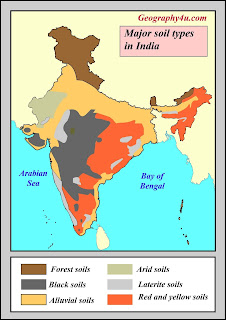Indian soils
| Indian soils |
https://sanjugkmcgill.blogspot.com/2021/01/indian-soils.html

Published by Sanjeev sir
Types of soils of India and their distribution
Sansar LochanMay 19, 2017Geography, Geography of India
indian_farmer_village
Contents [hide]
1 soil types
2 Soils of India - Map
2.1 alluvial soil
2.2 Black soil
2.3 Red clay
2.4 laterite clay
2.5 desert soil
2.6 Other Soils
3 Fertility of Soil https: // cdN8tEE & s = 10
A wide variety of soils are found in a large country like India. Although the survey of Indian soils has been done by many government and non-government organizations, but today what I am going to tell you about the classification of soils is from the Indian Agricultural Institute, Delhi. based on survey.
In terms of convenience, varieties of soils found in different regions of India are divided into five types of soils.
Soil Type - TYPES
Alluvial Soil
Black Soil
Red Soil
Laterite Soil
Sandy (desert-Desert Soil) soil
Note: Alluvial, black, red and yellow soils contain potash and lime, but they lack phosphoric acid, nitrogen and humus. Humus is very much found in laterite soil and sandy soil but there is lack of other elements.
Soil of India - MAP
indian_soil alluvial soil
Alluvial Soil is also known as loam and alluvial soil. The soil brought by the rivers is called alluvial soil. This soil is found in all the northern plains of our country. It is a fertile soil by nature. The alluvial soil found in northern India is brought by three main rivers - Indus, Ganga and Brahmaputra. Therefore, we can understand that this soil is found in the northern part of Rajasthan, Punjab, Uttar Pradesh, Bihar, West Bengal and half of Assam. Alluvial soil is also found on the eastern coast in the southern part of the Indian peninsula. This soil is very useful for agriculture.
black soil
A feature in Black Soil is that it retains moisture for a long time. This soil is also called cotton soil or rag soil. Black soil is important for cotton yield. This soil is found in lava region. Thus, this soil zone consists of Gujarat, Maharashtra, Madhya Pradesh, western part of Andhra Pradesh and northern part of Mysore.
Red clay
This is a rocky soil. This soil is found mostly in southern India. Red Soil areas are spread in the southeastern part of Maharashtra, in Madras, in Andhra, in Mysore and in the eastern part of Madhya Pradesh, in Orissa, Chhota Nagpur in Jharkhand, and in West Bengal.
Laterite clay
Areas of laterite soil are found in the form of a thin strip on the south-east side of the southern peninsula. These soils can be seen from West Bengal to Assam.
Desert soil
This soil is found in the Thar region of Rajasthan, in the southern part of Punjab and in some other parts of Rajasthan. The Thar Desert alone is spread over an area of 1,03,600 square kilometers.
Other soils
Apart from this, different types of soil are also found. Some soil names are different in different places.
FERTILITY OF SOIL
In terms of yield, the soil should be so firm that it can hold the roots of the plants and on the other hand it should be so soft that it can absorb the water completely. At the same time, it is also necessary to have a balanced amount of alkali in the soil behind soil fertility.
If seen, fertile soil is found in the Doab region of Ganga-Jamuna, the east coast and west coast regions and some lava regions in India. Very few fertile soils are found in Thar Pradesh, Gujarat and hilly regions. The remaining parts are less fertile.
Comments
Post a Comment